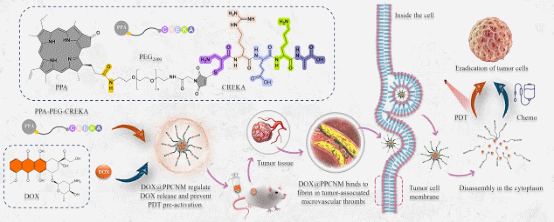Current drug carriers, while effective in mitigating therapeutic side effects, frequently elicit non-drug-related adverse reactions, including hepatorenal toxicity, oxidative stress and allergic responses. To address these issues and enhance drug efficacy, we propose a “drug-carrying-drug” strategy that integrates photodynamic therapy (PDT) with chemotherapy for potential tumor eradication.
In a study published in Biomaterials Advances, a collaborative research team led by Professor CHEN Zhuo from the Fujian Institute of Research on the Structure of Matter (FJIRSM), Chinese Academy of Sciences, and Chief Pharmacist YANG Lin from Fujian Cancer Hospital, has developed a multifunctional micellar carrier, PPCNM.
This innovation specifically overcomes two fundamental limitations of conventional photosensitizers: aggregation-induced photodynamic inactivation and dispersion-mediated photobleaching. By addressing these challenges, PPCNM establishes a novel platform for enhanced stability and therapeutic efficacy in PDT applications.
PPCNM is constructed through the PEGylation of pyropheophorbide-α (PPA), a porphyrin-based photosensitizer, and its conjugation with the tumor-targeting pentapeptide CREKA. Before entering tumor cells, PPCNM remains in an aggregated state to prevent photobleaching.
Upon internalization, it disassembles to activate PDT and simultaneously enable the stable delivery of doxorubicin (DOX). The DOX-loaded PPCNM (DOX@PPCNM) not only mitigates photobleaching and phototoxicity caused by premature PDT activation but also alleviates adverse effects associated with chemotherapeutic monotherapy. The fibrin-specific CREKA peptide, which targets tumor vasculature, enhances the precise delivery of both photosensitizers and chemotherapeutics to tumor tissues.
This study presents a promising strategy for developing a dual-drug targeted delivery system combining PDT with other therapies.

Schematic illustration of the design, preparation and therapeutic mechanism of DOX@PPCNM (Image by Prof. CHEN Zhuo’ s group)
Contact:
Prof. CHEN Zhuo
Fujian Institute of Research on the Structure of Matter
Chinese Academy of Sciences
Email: zchen@fjirsm.ac.cn